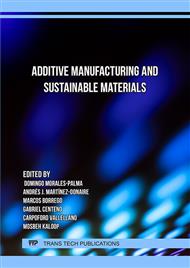p.111
p.119
p.131
p.139
p.149
p.157
p.165
p.177
p.187
Laser Powder Bed Fusion (L-PBF) for Cellular Structures Formed by a Heterogeneous Skeleton
Abstract:
Cellular structures such as lattice or triply periodic minimal surfaces (TPMS) present interesting applications in different industry sectors due to their high specific strength (the ratio strength/weight), elastic modulus and energy absorption. Some applications focus on new geometries for heat exchangers due to a higher cooling performance. In addition, different sectors demand lighter materials and structures maintaining component mechanical properties but reducing its weight, which is the case of microstructures. Microstructures composed by rigid skeletons are able to maintain the global component stiffness. The main challenge is designing with optimized microelements size, shape, and topology. The internal cavities and complex geometries of these parts are an impossible barrier for most of the manufacturing processes. Thus, one of the most suitable processes for these types of components is Additive Manufacturing, yet these microstructures formed by a heterogeneous skeleton with cavities is still a real challenge. In this work, different case studies for microstructures manufactured by Laser Powder Bed Fusion (L-PBF) are presented and both, manufacturing process parameters and components analysis, are performed.
Info:
Periodical:
Pages:
149-156
Citation:
Online since:
October 2023
Price:
Сopyright:
© 2023 Trans Tech Publications Ltd. All Rights Reserved
Share:
Citation:



